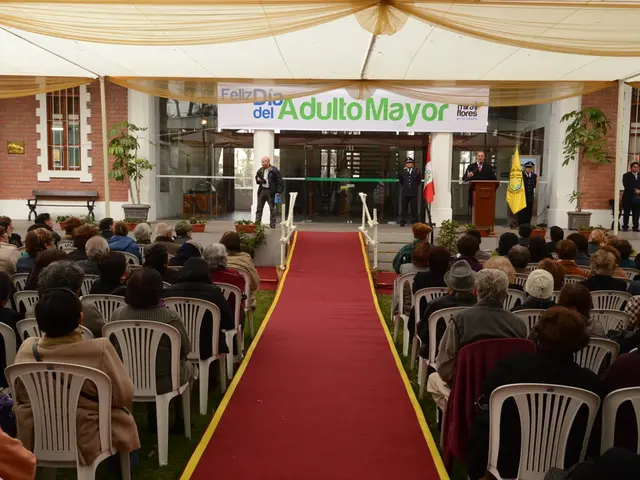Identifying Cultural Influences in Contemporary English Broadcasting and Publications
Modern English media is a melting pot of diverse cultural influences, shaping how stories unfold and resonating with global audiences. In this interconnected world, understanding these cultural currents helps us appreciate the history, language, and dynamics that define media narratives.
Western Cultural Themes Conquer the Screen
Globalization has propelled Western narratives onto our screens, creating universal templates that are mimicked and adapted in various media forms. Blockbuster movies, viral trends, and even social media platforms frequently embrace Western themes that resonate deeply with audiences, from the quintessential 'hero's journey' to the portrayal of individualism.
While this diffusion of Western themes across media can be seen as cultural homogenization, it also serves as a bridge, helping to bridge cultural divides by offering relatable touchpoints.
Asian Culture Rises, Redefining the Entertainment Landscape
Over the last few decades, Asian cultures have asserted influence over English media, challenging and enhancing its narrative scope. The rise of Korean pop culture, or Hallyu Wave, exemplifies this shift, with Korean dramas and music like BTS setting global trends and redefining entertainment formulas.
BTS's success can be attributed to their unique blend of traditional Korean musical aesthetics and universally appealing themes. Their songs address complex issues like mental health and social justice, capturing emotions that defy language barriers.
Language and Cultural Nuances - Keys to Authentic Storytelling
Words carry the weight of culture - through the phrases chosen, idioms employed, and regional dialects, language weaves cultural subtleties into media narratives. By crafting stories around historical and regional dialects, media can transport us back in time or offer a glimpse into vastly different perspectives and communities.
Take series like "Downton Abbey" and "The Crown," where intricate exploration of British culture rests on period-accurate dialogue, immersing us in their cultural ethos. On the other hand, regional English dialects lend narratives texture and depth, allowing us a glimpse into class, origin, attitudes, and deeply held beliefs.
Historical Narratives - Weaving Cultural Legacy and Impact
History provides fertile ground for cultural expression in media, as narratives frequently draw upon historical backdrops to address contemporary issues. History-inspired media illuminates cultural legacies, challenges societal norms, and serves as a reflective medium for questioning and understanding cultural mores.
For example, series like "The Man in the High Castle" offer dystopian scenarios based on alternate history, prompting us to reflect on key themes of resistance, identity, and ideology. Showcases like "12 Years a Slave" and "Django Unchained" delve into largerissues surrounding slavery, exemplifying how narratives rooted in cultural history can foster deeper reflection and societal progress.
Digital Transformation and Cultural Hybridization
Technological advancements have democratized media production, allowing for greater cultural hybridization and exchange of ideas. Streaming platforms, YouTube, social media, and more offer a stage to showcase diverse voices and experiences, breaking down barriers and amplifying global stories.
Platforms like Netflix and Amazon Prime Video have embraced this diversity, offering international content with subtitles to cater to evolved viewer expectations and tastes.
Embracing cultural influences in media doesn't just mean sharper media literacy - it means engaging more deeply, empathetically, and inclusively with the stories that shape our world. Today's media consumer benefits from understanding the historical, linguistic, and cultural forces that underpin narratives, fostering a richer, more nuanced appreciation for the stories they watch, read, or listen to.
By becoming aware of cultural influences, you're well-equipped to critique, appreciate, and even contribute to the media creation process. This consciousness fosters a more inclusive media environment, one where diverse stories are celebrated and appreciated. So keep diving into narratives that speak to you, question the constructs that guide them, and explore new perspectives that challenge your own. Through ongoing engagement, you help shape a future where media is an even more powerful tool for unity and cultural appreciation.
FAQs
1. What are cultural influences in modern English media?Cultural influences in modern English media encompass shared customs, traditions, beliefs, values, and historical events that have sprung from diverse cultures around the world. They weave into storylines, character development, themes, and visual aesthetics, ensuring narratives resonate with a wide audience.
2. Why is understanding cultural influences important in media?Understanding cultural influences is essential in media because it enriches our perspective, humanizes characters, challenges stereotypes, encourages empathy, and breaks down cultural barriers. By understanding different cultural viewpoints, we can better appreciate the global context behind media narratives and enjoy a more nuanced, informed, and inclusive media experience.
3. How do cultural influences shape storytelling in English media?Cultural influences create layers of meaning, subtext, and richness in English narratives by incorporating customs, beliefs, and historical events into storylines. They push boundaries, challenge conventions, and combine elements from various cultures to create unique, compelling stories that connect with audiences across the globe.
4. How do cultural influences alter audience engagement with modern media?Cultural influences provide relatable touchpoints that can deepen audience engagement by connecting stories to shared experiences, beliefs, and emotions. By understanding the cultural influences that inform media narratives, we can appreciate the subtleties and complexities embedded within them and participate more fully and empathetically in the conversations they generate.
5. When did cultural influences first become apparent in English media?The roots of cultural influences in English media can be traced back to folklore and tales passed down through oral tradition. However, their explicit incorporation and documentation can be observed from the emergence of printed literature in the Middle Ages, as writers like Geoffrey Chaucer and William Shakespeare began to draw upon a rich interplay of historical events, legends, and customs in their works.
References:1. Thompson, P. (2020). Social Media and Cultural Change. Cambridge Scholars Publishing.2. McManus, J. (2020). The Transformation of TV Drama in an Age of Internet Television. Routledge.3. Kaplan, A. (2019). Representation in American Television: Identity Politics Across Race, Gender, Sexuality, and Class. Routledge.4. Frohmann, S. B. (2008). Globalizing Media: Trends, Problems, and Prospects. Taylor & Francis.5. Kucich, D. (1987). Novel Cultures: Ideology, Aesthetics, and the Subject of Nineteenth-Century Fiction. University of Minnesota Press.6. Wicke, J. (2002). Advantage America: Cultural Politics in the New World Order. University of California Press.7. Landow, G. P. (2006). Hypertext 3.0: Critical Theory and New Media in an Era of Globalization. Johns Hopkins University Press.8. Dettloff, S. (2019). The Cultural Turn in Media History. Bucknell University Press.9. Gumbert, D. D. (2012). Translating Cultural Differences in Stereotypes: How Different Languages Influence Character Perception in Movies. Journal of Business & Entrepreneurship Education, 11(2), 1-20.10. Archer, B. (2020). Postcoloniality, Hybridity, and the Globalization of Popular Culture. Polity.
- Western narratives, diffused globally through modern media, offer templates that resonate deeply with audiences, showcasing themes like the 'hero's journey' and individualism.
- The Hallyu Wave, led by Korean pop culture, has redefined entertainment landscapes, with shows like BTS addressing complex issues and bridging cultural divides.
- Language and its nuances play a vital role in authentic storytelling, as media immerses us in different cultural ethos using regional dialects and historical dialogue.
- History-inspired media provides a platform to reflect on contemporary issues, illuminating cultural legacies and challenging societal norms, as seen in shows like "The Man in the High Castle" and "12 Years a Slave."
- Technology has democratized media production, allowing for the exchange of diverse cultural voices and stories, shaping a rich, inclusive, and interconnected media environment.
- To engage more deeply and inclusively with narratives, dive into stories that speak to you, question constructs guiding them, and explore new perspectives that challenge your own.
- Understanding cultural influences allows us to appreciate the subtleties and complexities within media narratives and fosters a richer, more nuanced media experience.
- By becoming aware of cultural influences, we equip ourselves to critique, appreciate, and even contribute to the media creation process, promoting a more inclusive media environment where diverse stories are celebrated and appreciated.







